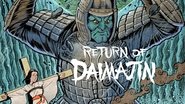OllieSuave-007
Daiei Studios' Return of Daimajin is the first sequel to the movie featuring the giant stone god. In this plot, villagers defy an evil warlord's order to turn over one of their protectors, Lord Juro (Kôjirô Hongô), and end up seeing their people being brutally attacked by the warlord and his soldiers. As a result, the villagers pray upon Daimajin, the great stone god, to fight for them.The plot, I thought, was not as suspenseful and solid as the original movie, as it has more of a general "turn over your hero to us or we'll screw your village over" story line. But, there is plenty of sword-wielding and good guy vs. bad guy action to keep the film engaging, and the nastiness of the villains will make you want to root for the god to awaken and teach them a lesson they'll never forget - showing them that they shouldn't mess with the faithful.The acting was pretty good, cinematography was brilliant and special effects were neat. Also, you really can't go wrong having the great Akira Ifukube score the music soundtrack to this film, though, much of the music is reused or reworked from the scores of past Toho films.Overall, it's a rather entertaining feature that fans of Japanese sci-fi/fantasy films could enjoy.Grade B-
kevin olzak
"Return of Giant Majin" (pronounced 'Mah-jeen') was a sequel to "Majin, the Monster of Terror," both TV staples from decades past, followed by a third that wouldn't see release in the US for nearly 40 years (all three completed in 1966). The plots are very similar, and the God Majin doesn't walk until an hour into each feature, but the spectacle of his presence beats Godzilla all to hell. This Japanese version of The Golem, who aided the Jews against their oppressors, was a creation of Daiei Studios, but produced far fewer films than their best known monster, Gamera. Despite his rubbery appearance, Majin truly lives up to his majesty, and the villains are so evil and despicable that one cannot help but cheer their defeat. Pittsburgh's Chiller Theater aired each film only once: "Majin, the Monster of Terror" on Aug 16 1969 (followed by 1957's "The Disembodied"), "Return of Giant Majin" on May 11 1974 (following 1965's "The Navy vs. the Night Monsters").
Woodyanders
An evil warlord takes over a peaceful small village and enslaves the residents of said community. The noble Lord Juro (nicely played by Kojiro Hongo) tries to oppose the warlord to no avail. So the feisty Lady Sayuri (a sound and affecting performance by the lovely Shiho Fujimura) prays to the giant statue Majin to come to life and rescue her people. Director Kenji Misumi and screenwriter Tetsuro Yoshida deliver a simple and engrossing tale of wrongdoing and retribution which benefits from a steady pace, a vivid and convincing evocation of 17th century feudal Japan, an equally strong and credible depiction of a bleak, harsh and brutal world, uniformly fine acting from a capable cast, several exciting rough'n'ready swordfights, a full, rousing, dynamic score by Akira Ifukube, picturesque cinematography which makes neat occasional use of stately fades and dissolves, clearly drawn characters (the good guys are virtuous and engaging while the villains are extremely cruel and despicable), a grimly serious tone, nifty and impressive special effects, and, of course, a thrilling last reel ferocious mondo destructo rampage by the mighty Majin. Moreover, there's an interesting pronounced religious aspect to the narrative: Lady Sayuri gets tied to a stake and narrowly avoids being burned alive, the water of a lake parts as Majin rises forth to save the day (this particular image is truly striking), and the main heavy winds up being crucified on the sail of his boat. A really solid and satisfying Japanese fantasy feature.
Scott-42
Better in the first in that there is a fun adventure story included and the writers aren't afraid to make a few sacrifices along the way to give the story some extra weight. The Majin's vengeance is better thought out than it was in the first film, and He is much more of a hero to the villagers this time out.



